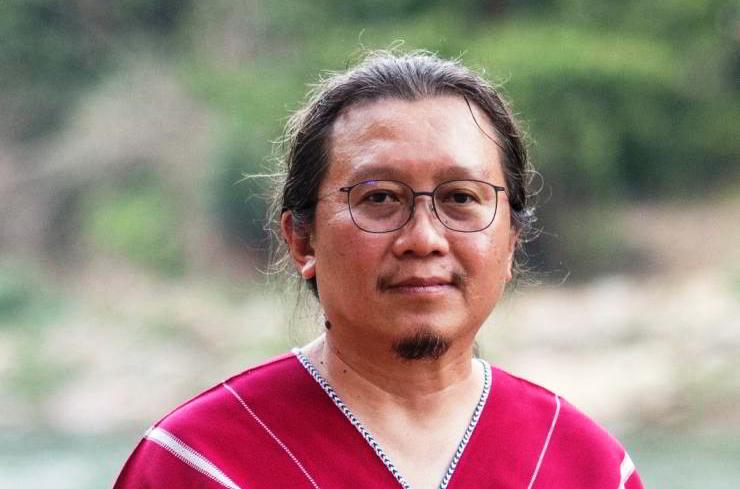Myanmar. Paul Sein Twa. Preserving Ancestral Territory.

“What we would like to achieve when we talk about peace. Peace means self-determination. Peace means biological conservation. Peace means revitalization of our culture and Indigenous knowledge: our way of life.” Environmental activist Paul Sein Twa explains to us.
Paul Sein Twa, a Karen environmental activist and executive director of the Karen Environmental and Social Action Network (KESAN), has lived through several periods of political turmoil in Myanmar, passing from one military regime to another, and navigating predatory international development and centralisation reforms under the democratic mandate of former State Counsellor Aung San Suu Kyi.
Out of the devastation caused by teak logging in the Karen areas, an ambitious conservation project known as the Salween Peace Park has emerged, managed in part by KESAN. The Karen-administered park now covers 5,485 square kilometres, including more than 350 villages
and 27 community forests.
According to Paul, the majority of people living in the park itself have been displaced since the military coup in 2021 and the escalation of the civil war. The park continues its conservation mission, working with the revolutionary Karen National Union (KNU) government towards an autonomous Karen state and recognition under Burmese law, despite the ongoing threat of air strikes.
Could you talk about how the Salween Peace Park came about?
“The Peace Park initiative started during the peace process in early 2012. The armed conflict prevented bigger projects like dams and mining from penetrating this area. But the ceasefire facilitated them – (the government) tried to bring them in as incentives to the resistance Leaders. ‘Development for peace’ or something along those lines. But we very much disagree with that, because the kind of peace that we want is the freedom to be able to govern ourselves, to be able to make our own decisions about our own lives, is not our resources, our land.”
“That kind of autonomy in the context of the federal system has always been our call for political reform. The ceasefire brought other kinds of threats. It was not only the military government wanted to build hydropower dams along the Salween River. We were also facing foreign investment and other emergent actors like the World Bank, the Asian Development Bank and the Japan International Cooperation Agency.
“Everything was top-down. With the Salween Peace Park, the idea was that we need to have initiatives that show what we want, what our vision is, and what we would like to achieve when we talk about peace.
Peace means self-determination. Peace means biological conservation. Peace means revitalization of our culture and Indigenous knowledge:
our way of life.”
How are colonial forestry practices being replaced by Karen-led forestry?
“The usual way to conserve and manage the forest and the landscape is through a top-down conservation governance model. We have a different model: our Indigenous way of doing. We started to demarcate and map the Indigenous territory called Kaw customary lands. In each unit of land, you have between 10 and 20 villages that you can say own that land maybe own is not the right word to use in Indigenous terms!
So, the land doesn’t belong to you?
“We belong to the land because when we die, we go back to the land. Everything we use from the land is through a stewardship philosophy, meaning we are not the owners but we are trusted to take of it. We try to recognize each customary territory and make people in that area say yes, this is our territory, this is so valuable, this is so important, so we need to take care of it. That’s why even though the Salween Peace Park is a huge area, it’s not difficult to bring people together because we have the same understanding, concerns and vision.”
“We don’t want to see our land being grabbed or exploited for any extractive activities or other development projects. With forest management, the colonial [form] where everything is decided by the forestry department doesn’t work because the forestry department has very few resources, so they cannot look after big areas. We have proof that after 10 years, we can show improvement compared to a government reserve or national part.”
How have the Salween Peace Park community self-government and the KNU managed the conflicting foreign interests in Myanmar’s natural resources amid the civil war?
“In post-conflict times, usually follow Western governments development models. We need to step up and promote alternatives to the Western or capitalistic way of doing development. The path that we do want is more ecological. In terms of livelihoods, it should be looking at agroecological approaches and food sovereignty, and addressing the issues of farmers who have been impacted by armed conflict and other crises like landlessness because of land grabs.”
“The law of customary land (is that people) should get a fair share, nor that the government seizes all this land, pays a little compensation, and then leases the rest to a company for a hundred years. We want a new model in which communities are involved through all of the development process. We need to be different and not follow the failed pathways
of capitalism.”
Lital Khaikin/NI – Photo: Goldman Environmental Prize)



